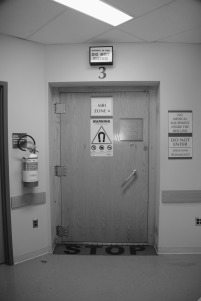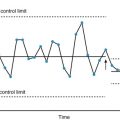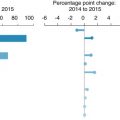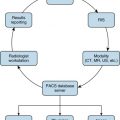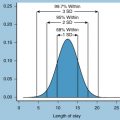Abstract
There are many complex noninterpretive skills specific to MR imaging, primarily related to safety and quality assurance issues, that are critical for the consistent production of safe and high quality magnetic resonance (MR) examinations. Multiple organizations, including the American College of Radiology (ACR), Federal Drug Administration (FDA), and The Joint Commission are involved in establishing and maintaining guidelines, regulations, and best practices related to MR safety as well as providing guidance for implementing adequate quality assurance programs. MR safety risks are related to the three primary components of the MR system and are particularly important to recognize because they are largely preventable and potentially catastrophic. The static magnetic field can result in projectile injury and interference with or displacement of implanted medical devices; the time-varying radiofrequency magnetic field can result in tissue heating and burns; and the time-varying gradient magnetic field can result in acoustic injury, biologic effects such as peripheral nerve stimulation, and interference with implanted medical devices. In order to maintain a safe MR imaging suite, it is necessary to preserve a controlled environment with restricted access, an effective screening protocol for both people and objects, and appropriate training of MR personnel. It is also important to be aware of safety issues pertinent to specific patient populations, including pediatric, pregnant, and unconscious or incapacitated patients. Noninterpretive skills related to quality assurance, control, and improvement are also complex and include understanding MR equipment and physics, techniques for artifact reduction, and how to optimally design and implement MR protocols.
Keywords
MRI artifacts, MRI quality assurance, MRI quality control, MRI quality improvement, MRI safety
Introduction
Magnetic resonance imaging (MRI) is used in the diagnosis of patients with many conditions, and while the interpretive skills necessary to appropriately interpret the MRI images are complex, so too are the noninterpretive skills. Many of these issues come to the radiologist’s attention on a daily basis—for example, issues concerning magnetic resonance (MR) safety, whether a patient will be safe in the MRI environment, and issues regarding artifacts seen on an MRI. Intravenous gadolinium contrast (discussed in Chapter 20 ) adds another layer of complexity in the daily performance of MRI, especially in light of ongoing developments with regard to nephrogenic systemic fibrosis and gadolinium deposition in the brain. The two main practice domains that are important to understand are those pertaining to patient safety and those needed for quality improvement, for example, identification and improvement of image quality as well as establishing the best workflow environment.
Magnetic Resonance Imaging Safety
MR scanners are classified as “nonsignificant risk devices” by the US Food and Drug Administration (FDA), as long as specified parameters and best practices are followed. In contrast to imaging modalities that rely on ionizing radiation, which is associated with carcinogenesis, cataract formation, and other complications, MRI uses static magnetic fields, time-varying gradient magnetic fields, and time-varying radiofrequency (RF) magnetic fields, which tend to be more benign. Nevertheless, each of these fundamental components of the MR system presents its own unique set of safety issues: the static magnetic field can result in projectile injury as well as the displacement of, interference with, and/or permanent damage to implanted medical devices; the time-varying RF magnetic field can result in tissue heating and/or burns; and the time-varying gradient magnetic field can result in peripheral nerve stimulation and/or acoustic injury. All of these risks, however, are generally the result of failure to appropriately follow safety guidelines. Therefore, MR safety risks are particularly important to recognize because they are largely preventable and potentially catastrophic.
A turning point in the history of MR safety occurred in 2001, when a 6-year-old boy died as the result of projectile injury during an MR exam. Many systematic issues were identified that played a role in allowing this tragedy to occur, such as deficiencies involving the safety policies and physical design of the MR facility and insufficient training of MR personnel. In response to this incident and others, the American College of Radiology (ACR) published the first edition of their guidance document on MR safe practices in 2002, which addressed many of the systematic issues identified in the 2001 tragedy, and offered MR facilities across the country a template to follow to develop and strengthen their own set of MR safety policies. Multiple organizations are currently involved in establishing and maintaining guidelines, regulations, and best practices related to MR safety. For example, the FDA establishes regulations for the safe operation of an MR scanner, such as setting exposure limits for RF power deposition, and also regulates MR contrast agents. The American Society for Testing and Materials (ASTM) develops standard test methods for determining the MR safety of medical devices, and several additional organizations, such as the ACR and Joint Commission, serve as accrediting bodies. Specific guidelines are in continuous evolution as technology advances and MR scanners are able to generate stronger static magnetic fields, faster gradient magnetic fields, and more powerful RF magnetic fields. Up-to-date MR safety information is available from many sources such as the ACR’s website and MRIsafety.com .
Static Magnetic Field–Related Safety Issues
MRI was introduced as a clinical imaging modality in the early 1980s, thereby exposing large populations to powerful magnetic fields for the first time. Although the first MR scanners generated field strengths in the range of 0.05 to 0.35 T, modern MR scanners are able to produce field strengths greater than 10 T. For reference, the magnetic field strength of the Earth is approximately 0.05 millitesla (mT), or 0.5 gauss (G) (1 T = 1000 G). A large body of literature has characterized the interactions between magnetic fields and various biological processes, including cell growth and reproduction, DNA structure and gene expression, nerve conduction, cognition, vision, cardiovascular physiology, and immune function, among many other processes. Although more research must be done at field strengths greater than 3 T, there is currently no conclusive evidence of adverse biological effects resulting from exposure to field strengths used in clinical practice. The FDA has set an upper limit for static magnetic field exposure of 8 T for adults, children, and infants greater than 1 month of age and 4 T for infants less than 1 month of age, given the lack of data at very high field strengths (although field strengths greater than 4 T require Institutional Review Board approval and an investigational device exemption).
There are multiple safety issues associated with the static magnetic field including projectile injury and the displacement of, interference with, and/or permanent damage to, implanted medical devices. To understand the safety risks associated with the static magnetic field, it is first necessary to be familiar with the hardware of the main magnet and basic principles of electromagnetism, which will briefly be reviewed.
The main magnet fundamentally consists of a coil of wire wrapped around the bore through which electric current is applied. The flow of current induces a magnetic field, with its polarity depending on the direction of current flow, and its strength depending on several factors including the magnitude of the current. Because conductors inherently resist and dissipate current at temperatures significantly greater than absolute zero, a constant source of electricity would be necessary to maintain a given field strength under these circumstances, which is not practical at high field strengths due to cost. Therefore, modern MR scanners use superconducting coils, which are immersed in cryogens and cooled to a temperature approaching absolute zero. Current is applied to the superconducting coil over the course of several hours until the desired field strength is reached, and the coil is then able to maintain a given field strength without a constant supply of electricity, as long as its temperature is maintained. Modern MR scanners typically have an additional set of superconducting coils external to the main set, which generate a magnetic field that cancels out a portion of the fringe field, or the static magnetic field that extends beyond the confines of the MR scanner. The static magnetic field is strongest and most homogeneous at the center of the bore, or the isocenter. The rate at which the static magnetic field strength changes with distance is referred to as the spatial gradient.
It is also important to be familiar with physical principles that determine the interaction between magnetic fields and various types of matter with differing magnetic properties. All matter, including human tissue, is associated with some degree of magnetism, depending on its electron configuration. The degree to which a substance becomes magnetized in the presence of an external magnetic field is referred to as its magnetic volume susceptibility, or simply susceptibility. Substances are categorized as diamagnetic, paramagnetic, or ferromagnetic based on their susceptibility.
Diamagnetic substances have a negligible, negative susceptibility to magnetic fields and are minimally repelled by magnetic fields. These substances have paired valence electrons and therefore no net intrinsic magnetic moment. Examples of diamagnetic substances include water and most human tissues.
Paramagnetic substances have a weak, positive susceptibility to magnetic fields and are slightly attracted to magnetic fields. Paramagnetic properties are due to the presence of unpaired valence electrons, resulting in a small net intrinsic magnetic moment. Examples of paramagnetic substances include ions of certain metals such as iron and gadolinium. Although human tissues contain paramagnetic materials such as iron ions, they are distributed in various molecules such as hemoglobin and hemosiderin, which are only weakly paramagnetic and not sufficiently concentrated to routinely interact with an external magnetic field.
Ferromagnetic substances have a large, positive susceptibility and are strongly attracted to magnetic fields. Like paramagnetic substances, ferromagnetic substances have unpaired valence electrons. However, the much larger susceptibility of ferromagnetic substances is related to magnetic domains, within which large numbers of magnetic moments become aligned in the presence of an external magnetic field. Ferromagnetic materials are not naturally present in human tissues but may be present as foreign bodies or implanted medical devices. Examples of ferromagnetic materials include elemental iron, nickel, and cobalt. Metals or alloys that do not contain elemental iron, nickel, or cobalt are not ferromagnetic and therefore are not associated with a risk of projectile injury, although they are associated with a risk of burns, as all metals are efficient conductors of heat (see the next section for further detail).
The static magnetic field exerts translational and torque forces on ferromagnetic objects, which are related to a number of factors including the susceptibility, mass, and shape of the object; the distance and orientation of the object with respect to the magnet; and the strength and spatial gradient of the magnetic field. As an example, a 1.5-T magnet can lift and transport a car in a junkyard but exerts no significant force on a human body in an MR scanner due to differences in their magnetic properties. The translational force exerted by a static magnetic field may attract and accelerate ferromagnetic objects toward the magnet, resulting in the projectile effect . Given the presence of a ferromagnetic object in a strong static magnetic field, this force is largely dependent on the spatial gradient. Because the static magnetic field is very homogeneous near the isocenter, the spatial gradient within the central bore is small, and the translational force is weak. As a result of shielding techniques used in modern MR scanners, the fringe field is highly concentrated around the bore, resulting in very high spatial gradients at the periphery of the bore and the potential for overwhelming, abrupt, and unexpected translational force on a ferromagnetic object that is brought too close to the magnet ( Fig. 22.1 ).
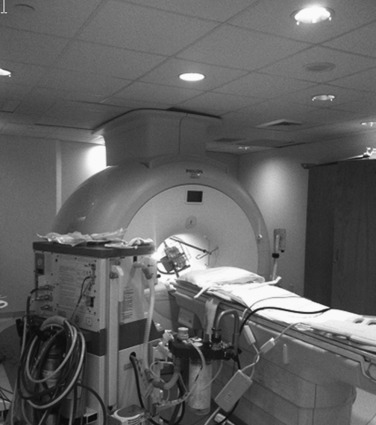
All ferromagnetic objects, regardless of mass, pose a safety risk in the fringe field. For example, even a paperclip can accelerate up to speeds of 40 MPH in a 1.5-T magnetic field and cause significant injury. The projectile effect is most likely to occur at field strengths greater than 30 G. However, translational attraction of a medical device can be more specifically characterized by the deflection angle test, which was devised by the ASTM. In this test, a device is suspended by a thin string at various static magnetic field strengths, and the angle at which the device is displaced from its vertical axis is measured. If the device deflects less than 45 degrees, then the magnetically induced force is less than the force exerted on the device by gravity, and it is assumed to be safe at that field strength.
The torque force exerted by a static magnetic field causes ferromagnetic objects to rotate and align parallel to the direction of the magnetic field. Given the presence of a ferromagnetic object in a strong static magnetic field, this force is largely dependent on the field strength and is strongest at the isocenter. Therefore, the torque force presents the greatest safety risk for patients with implanted medical devices with ferromagnetic components such as certain aneurysm clips, cochlear implants, and cardiac pacemakers. The ASTM has also devised a standard test to evaluate the torque force exerted on a medical device in a static magnetic field. In this test, a device is secured by a spring and placed on a holder at the isocenter, and the angular deflection of the holder is measured. If the maximal torque is less than the product of the longest dimension of the device and its weight, then the magnetically induced force is less than the force exerted on the device due to gravity, and it is assumed to be safe at that field strength with respect to torque forces.
The static magnetic field may also temporarily interfere with and/or permanently damage implanted electronic medical devices. For this reason, the 5-G line must always be clearly demarcated in the MR environment; this line defines the perimeter within which the static magnetic field exceeds 5 G and poses a risk to the general public, particularly individuals with cardiac pacemakers and other implanted electronic medical devices ( Fig. 22.2 ). Moreover, some medical equipment (e.g., respirators) may be approved in the MR environment outside the 5-G line but can act as a projectile when brought within the 5-G line. More specific information with regard to various types of medical devices is separately discussed.
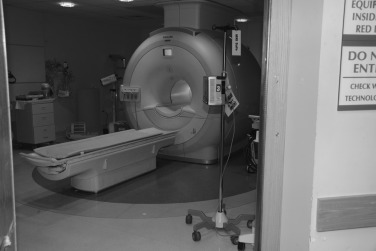
Although implanted medical devices are increasingly being composed of nonferromagnetic materials, there are many devices and metallic foreign bodies that may represent a contraindication to MRI. A metallic foreign body in the eye or in close proximity to large blood vessels or vital organs may represent an absolute contraindication (unless the composition of the foreign body can be determined or it can be removed). Implants that have not been rated as MR safe or MR conditionally safe also may be a contraindication to MRI, including cardiac pacemakers and implantable cardioverter-defibrillators, nerve stimulators, cochlear implants, ferromagnetic aneurysm clips, hemodynamic monitoring and temporary pacing devices, pulmonary artery monitoring catheters, retained transvenous pacemaker and defibrillator leads, and transdermal patches. However, many manufacturers are now making such devices that are MR conditionally safe (e.g., cochlear implants and cardiac pacemakers). Moreover, a handful of centers nationwide have instituted safeguards that allow them to successfully image patients with devices that are not MR safe or MR conditionally safe, such as cardiac pacemakers or implantable cardioverter-defibrillators. The MR safety of specific devices can be determined from published written or electronic resources, product manufacturers, and/or peer-reviewed publications.
An additional safety concern related to the static magnetic field is potential biological effects, particularly those due to the magnetohydrodynamic effect, or the induction of a voltage in a conductive fluid that flows through a magnetic field. Examples of such fluids in the human body include blood and endolymphatic fluid. For example, ions present in blood flowing through the aorta generate a voltage across the vessel that results in artificial T-wave elevation on ECG. Although this effect is far too weak to cause arrhythmias even at high field strengths, it may result in faulty triggering on gated cardiac MR exams. Additionally, magnetohydrodynamic forces on the semicircular canals, retina, and surface of the tongue are thought to be a source of nausea, vertigo, flashes of light (magnetophosphenes), and metallic taste, which have been reported, especially at high field strengths.
The use of cryogens presents an additional safety issue in MRI. Modern MR scanners contain over 1000 L of cryogens to maintain the superconductive properties of the magnet. Liquid helium is the most commonly used cryogen, which is not inherently toxic but is associated with dangerous physical properties, including a boiling point of approximately –450°F and a thermal expansion ratio of greater than 750:1. In the event of a magnet quench, or sudden loss of superconductive properties of the magnet, the cryostat temperature rises above the boiling point of liquid helium, which rapidly vaporizes. If the MR system functions properly, the cryogen gas enters an escape valve and is discharged into the atmosphere. However, if the ventilation system fails, there is the potential for hundreds of liters of cryogens to vaporize into the MR environment. Because of its high thermal expansion ratio, 1000 L of liquid helium may explosively expand into over 750,000 L of gas during a full quench, posing several safety risks including cold exposure and frostbite, asphyxiation from oxygen depletion, physical injury from ejected material, and increased atmospheric pressure. Therefore, an intentional magnet quench is rarely indicated other than in extraordinary circumstances, such as a projectile restraining a patient in the magnet.
Radiofrequency Magnetic Field–Related Safety Issues
The main safety risks associated with RF electromagnetic fields include tissue heating and burns. RF pulses are short bursts of nonionizing, electromagnetic radiation that are used to excite protons within a given slice thickness of the patient and generate a measurable signal. The excited protons emit RF radiation as they relax back into their resting state, some of which is received by a coil and used to generate an image. However, only a small portion of the emitted RF radiation reaches the receiver coil, with the majority of energy absorption occurring within the patient according to Faraday’s law of induction. Because human tissues have some degree of conductivity, the RF field induces small electrical voltages within the patient, leading to induced currents and resistive heating, with the potential for tissue heating if the energy absorbed exceeds the patient’s capacity to dissipate heat. Current may also be induced in metallic objects within the RF field, such as components of the MR scanner or medical devices or wires on or within the patient, resulting in the potential for severe burns. The specific absorption rate (SAR) is used to quantify RF radiation exposure during an MR exam and is one of the safety parameters regulated by the FDA. In general, SAR refers to absorbed power per unit mass, typically expressed in watts per kilogram. The FDA has set SAR limits for the whole body, whole head, and local tissue in the head, torso, and extremities. Varying limits are in place for different modes of operation of the MR scanner as defined by the International Electrotechnical Commission, which represent varying levels of risk to the patient. Imaging parameters in the normal operating mode do not result in physiologic stress to the patient, whereas those in the first-level controlled operating mode have the potential for physiologic stress to the patient, warranting a risk-benefit analysis and medical supervision; those in the second-level controlled operating mode pose significant risk to the patient and warrant Institutional Review Board approval.
The whole-body SAR refers to the SAR averaged over the whole body over a 15-minute time interval and is limited to 1.5 W/kg in the normal operating mode and 4 W/kg in the first-level controlled operating mode, with SARs greater than 4 W/kg in the second-level controlled operating mode. The whole-body temperature should not increase more than 1°C during an exam. The head SAR refers to the SAR averaged over the head over a 10-minute time interval and is limited to 3 W/kg in the normal operating mode, with SARs greater than 3 W/kg in the second-level controlled operating mode. The local tissue SAR refers to the SAR averaged over any 1 g of tissue over a 5-minute time interval and is limited to 8 W/kg in the head or torso for the normal operating mode, with SARs greater than 8 W/kg in the second-level controlled operating mode. The local tissue SAR in the extremities is limited to 12 W/kg in the normal operating mode, with SARs greater than 12 W/kg in the second-level controlled operating mode. Multiple prior studies have confirmed the safety of imaging at a whole-body SAR of 4, with only mild increases in body temperature of less than 0.6°C and physiologically insignificant increases in skin temperature.
The SAR is determined by many factors including the static magnetic field strength, RF power (i.e., repetition time, flip angle, and duty cycle), tissue density and conductivity, and patient size, among other factors. In general, the SAR increases with the square of the static magnetic field strength and flip angle. It also increases with patient size, tissue conductivity, and duty cycle. For example, doubling the static magnetic field strength from 1.5 to 3 T or the flip angle from 90 to 180 degrees results in a fourfold increase in the SAR. For this reason, fast-spin echo sequences with long trains of 180-degree RF pulses generally have a larger SAR compared to gradient echo sequences, which do not use 180-degree refocusing RF pulses. At the same time, parallel imaging techniques may help reduce the SAR by decreasing the scan length. Patient parameters may also affect the SAR. For example, medical conditions including hypertension, diabetes, obesity, cardiovascular disease, fever, and/or advanced age may affect the SAR, and medications including beta-blockers, diuretics, amphetamines, and sedatives may interfere with the capacity to dissipate heat. Of note, certain human tissues with relatively poor vascularization, such as the eye and testis, are at increased risk of thermal injury, because blood flow acts as a heat sink. Moreover, these organs are also at increased risk due to their superficial location; the majority of RF energy absorption occurs superficially, because the incident RF wavelength is relatively long compared to the wavelength of human tissues.
The SAR can be estimated by adding the total energy of RF pulses in a given period of time, dividing by the duty cycle to determine the power, and dividing by the patient’s mass. MR scanners calculate the estimated SAR and do not permit imaging parameters outside of the normal operating mode without special authorization by MR personnel. There are multiple methods to reduce the SAR, such as increasing the time to repetition (TR), reducing the number of slices, reducing the echo train length, and reducing the refocusing pulse flip angle. Controlling the room temperature, humidity, and airflow also facilitates heat dissipation.
Metallic objects within the RF field may undergo significant heating because of their high conductive capacity, resulting in the potential for severe burns. Similar to the heating that occurs in human tissues, induced currents and resistive heating of metallic objects will occur if the time-varying RF or gradient field intercepts an electrically conductive loop. Metallic objects with an elongated or looped configuration, such as wires, leads, certain types of catheters, jewelry, and piercings, are therefore most likely to result in burns. Metallic substances such as tattoos, permanent makeup, and certain clothing microfibers may also pose a risk for burns. Of note, because the amplitude and duration of the gradient magnetic field are much smaller than the RF field, it does not pose a significant risk of thermal loading.
Although burns are one of the more common safety issues in the MR environment, they can be avoided if appropriate safety precautions are taken. The patient should change into a gown and remove any metallic objects such as piercings, MR-unsafe monitoring equipment, and drug-delivery patches. Care should be made to ensure that no metallic materials are in contact with the patient. If the patient has tattoos, permanent makeup, or other unremovable metallic objects, a cold towel should be placed over them to facilitate heat dissipation. The patient should be aware of the potential for thermal loading and burns and should always be able to communicate with MR personnel in the event of perceived heating. Additionally, leads, cables, and other potentially conductive objects should never be looped. Insulating material should be placed between the patient’s skin and RF coil and between the patient and any electrically conductive material that must remain in the MR system.
In addition to the safety issues, some patients, especially larger patients, will report significant sweating during the MR examination as their bodies attempt to dissipate the heat deposition in their bodies. This impacts patient comfort during the examination, and some patients may be unwilling to continue with the study because of these effects.
Gradient Magnetic Field–Related Safety Issues
MR scanners contain three orthogonal pairs of gradient coils, which generate linear variation along the static magnetic field to spatially encode the RF signal and allow spatial localization of the signal. Gradient magnetic fields are characterized by a maximum amplitude, measured in millitesla per meter, and a rise time, or the time interval necessary for the gradient to reach its maximum amplitude, measured in microseconds. The slew rate, which reflects the speed and strength of the gradient, can be calculated by dividing the maximum gradient amplitude by the rise time and is measured in millitesla per meter per second. Modern MR scanners are capable of slew rates greater than 200 mT/m/s. However, because higher slew rates are associated with a greater change in magnetic field strength over time, or d B /d t , pulse sequences with high slew rates, such as echo planar imaging sequences, are more likely to cause inductive currents according to Faraday’s law of induction. Although the RF and gradient magnetic fields vary rapidly with time, gradient magnetic fields are characterized by a greater d B /d t and a lesser maximum amplitude and are consequently more likely to result in induced currents and less likely to result in significant thermal loading.
Therefore, the primary safety issues related to gradient magnetic fields are caused by induced currents in the body or implanted medical devices, which can result in peripheral nerve stimulation, interference with the device, or burns. Stimulation of cells in the diaphragm, myocardium, or central nervous system are theoretical risks that could occur at much greater rates of change in magnetic field strength than those used in clinical practice. Additionally, because of the rapid time-varying nature of the gradient magnetic fields, vibration of gradient coils generates significant acoustic noise with the potential for temporary or permanent hearing impairment.
The potential for gradient magnetic field–induced physiologic effects at a given location in the body is determined by numerous factors, including the local d B /d t , average and maximum gradient magnetic field strength, and electrical properties of the tissue, among other variables. At the level of the cell membrane, the stimulation threshold varies with the amplitude and the duration of the applied pulse for a particular type of cell with a given excitability. The rheobase and chronaxie are measures of the excitability of cell membranes and refer to the minimum current amplitude that can depolarize the cell membrane and the minimum time required for an electric current of twice the rheobase strength to depolarize the cell membrane, respectively. For a peripheral nerve, the rheobase ranges from 6 to 20 T/s and the chronaxie ranges from 200 to 350 μs. Given these considerations, the FDA previously set an upper limit of 20 T/s for a pulse duration of 120 μs or more. However, following the introduction of echo planar imaging and other similar fast imaging techniques, which provide unique and valuable diagnostic information but rely on faster and stronger gradient magnetic fields, the FDA changed this recommendation and eliminated an absolute upper limit for d B /d t . Instead, the current FDA recommendation is to avoid severe discomfort or painful peripheral nerve stimulation, which effectively protects patients from more serious safety risks such as respiratory and cardiac stimulation, which occur at a much greater d B /d t . More specifically, the threshold for peripheral nerve stimulation is roughly 60 mT/s, at which point mild paresthesias may be perceived, with uncomfortable or painful peripheral nerve stimulation occurring at roughly 90 mT/s. Given this narrow margin between painless and painful peripheral nerve stimulation, it is important for the patient to alert the technologist of any perceived paresthesia so that corrective measures can be taken. If painful peripheral nerve stimulation is avoided, there is a negligible risk of respiratory or cardiac stimulation, which occurs at roughly 900 and 3600 mT/s, respectively. Gradient magnetic fields may also induce currents in implanted medical devices or other metallic objects, particularly those with looped or linear metallic components, such as pacemakers, cables, or retained wires, and result in malfunction of the device or burns. There are several reported cases of death as a result of pacemaker malfunction during MR exams.
An additional safety concern regarding gradient magnetic fields is acoustic noise, which results from the vibration of gradient coils (and to a lesser extent RF coils) due to the Lorenz force. The acoustic noise generated by vibrating coils may interfere with communication between the patient and technologist and also has the potential for temporary, or in extreme cases, permanent hearing impairment. The FDA has set an upper limit of 140 dB for allowable acoustic noise, which is the level at which hearing damage may occur. Additionally, manufacturers must place warnings for pulse sequences exceeding 99 dB in acoustic noise. Although most pulse sequences generate acoustic noise ranging from approximately 80 to 90 dB, echo planar imaging sequences can generate up to approximately 130 dB. It is therefore important to provide ear protection such as ear plugs and/or headphones, which can reduce effective noise levels by roughly 30 dB.
Magnetic Resonance Imaging Environment
Zoning
An important means of preventing MRI-related accidents is the division of the MR environment into four distinct zones, with increasingly restricted access from zone I to zone IV.
Zone I represents the areas outside of the MRI environment, which may include reading rooms and the entrance into the MR environment. It is the only zone that is freely accessible to the general public.
Zone II represents the interface between the unrestricted zone 1 and highly restricted zone III and may contain the reception and waiting areas, as well as the screening area where potential safety issues are identified. Patients are under the direct supervision of MR personnel in zone II. Zone III represents the portion of the MR environment in which the magnetic field poses safety risks. It contains the MR control room and scanner room. Zone III is physically restricted from general public access with locked doors, for example, passkey locking systems, and is only accessible to patients under the direct supervision of MR personnel. Patients in zone III have been cleared for the MR exam and are prepared for entry into the scanner. They remain under the direct supervision of MR personnel at all times. Additionally, magnetic field warnings are in place in this zone, which must clearly indicate the presence of a strong magnet that is always on, as well as the potential for danger related to the magnetic field. The 5-G line must be clearly demarcated; it defines the perimeter within which the magnetic field exceeds 5 G and may interfere with electronic medical devices.
Zone IV represents the room in which the MR scanner is located and is the highest risk zone ( Fig. 22.3 ). As in zone III, patients in zone IV remain under the direct supervision of MR personnel at all times. Of note, zone IV is located within zone III by definition.

